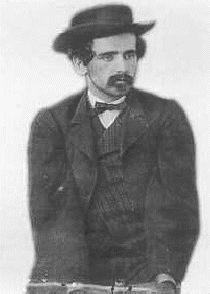
Biographic Sketch of Michael O'Laughlen
Michael O'Laughlen's Role in the Conspiracy

Biographic Sketch of Michael O'Laughlen
Michael O'Laughlen grew up on the same Baltimore street as his childhood friend, John Wilkes Booth. O'Laughlen worked as a manufacturer of ornamental plaster before joining the Confederate Army at the beginning of the Civil War. O'Laughlen was discharged in June 1862. He returned to Baltimore to work as a clerk in a family feed business.
Michael O'Laughlens's Role in the Conspiracy
Booth recruited O'Laughlen in the late summer of 1864 to participate in the plan to kidnap Abraham Lincoln and take him to Richmond, where he would--it was hoped--later be exchanged for Confederate prisoners-of-war. O'Laughlen, along with Booth and other conspirators, attended a March 15 meeting at Gautier's Restaurant in Washington where plans were laid for the kidnapping. The plot to intercept Lincoln's carriage while enroute to a play at the Campbell Hospital fell through when Lincoln changed his plans. Booth's next plan involved kidnapping Lincoln at Ford's theatre. O'Laughlen's was to have extinguished the gas lights at the theatre, but the plan was abandoned as infeasible.
O'Laughlen returned to Washington shortly before the assassination, but what role--if any--he played in Booth's final, desperate plan is unknown.
O'Laughlen voluntarily surrendered himself to federal authorities on April 17, 1865.
Michael O'Laughlen on Trial
At the 1865 Conspiracy trial, prosecutors tried to show that O'Laughlen had taken steps to assassinate General Grant, who O'Laughlen allegedly believed was staying at the home of Secretary of War Stanton.
The key evidence against O'Laughlen also links him to Booth's abandoned plan to abduct Lincoln. On March 13, Booth sent to O'Laughlen, then in Baltimore, a telegram from Washington: "Don't fear to neglect your business. You better come at once." Twelve days later, Booth sent another telegram to O'Laughlen: "Get word to Sam. Come on, with or without him, Wednesday morning. We sell that day for sure. Don't fail." Prosecutors suggested that the "business" referred to in Booth's telegraph was the kidnapping of Lincoln and that the "Sam" referred to in the second dispatch was Samuel Arnold.
Bernard Early, an acquaintance of O'Laughlen's, testified that he rode into Washington with O'Laughlen from Baltimore on the day before the assassination. Early said that the next day he waited with O'Laughlen at the National Hotel, where Booth had taken a room, for forty-five minutes before sending "up some cards to Mr. Booth's room for O'Laughlen" and leaving. Most incriminating, perhaps, was the testimony of Major Kilburn Knox, who testified that about ten-thirty on the night of April 13 O'Laughlen, wearing black clothes and a slouch hat, entered the home of Secretary of War Edwin Stanton and inquired of the Secretary's whereabouts. Knox said that O'Laughlen remained in the hall for a few minutes before being asked to leave. Two other witnesses also reported seeing O'Laughlen at the Secretary's home. Defense attorney Walter Cox argued that the prosecution witnesses were mistaken, and that on the night in question O'Laughlen innocently strolled the streets of the nation's capital enjoying the "night of illumination," the celebration of the Union victory that saw every public building in Washington lit with candles. Cox produced nine witnesses who supported O'Laughlen's alibi. Cox also argued that the evidence showed persuasively that O'Laughlen did nothing to further the assassination on the night of the fourteenth, which he spent drinking at Lichau House before departing for Baltimore the next day.
The Military Commission found O'Laughlen guilty and sentenced him to life in prison. He died two years later in prison at Fort Jefferson in the Dry Tortugas, Florida, a victim of yellow fever.
